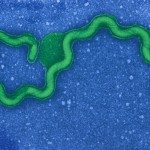Link to Pubmed [PMID] – 37917733
Link to DOI – 10.1371/journal.pntd.0011733
PLoS Negl Trop Dis 2023 Nov; 17(11): e0011733
Leptospirosis is a complex zoonotic disease mostly caused by a group of eight pathogenic species (L. interrogans, L. borgpetersenii, L. kirschneri, L. mayottensis, L. noguchii, L. santarosai, L. weilii, L. alexanderi), with a wide spectrum of animal reservoirs and patient outcomes. Leptospira interrogans is considered as the leading causative agent of leptospirosis worldwide and it is the most studied species. However, the genomic features and phylogeography of other Leptospira pathogenic species remain to be determined.Here we investigated the genome diversity of the main pathogenic Leptospira species based on a collection of 914 genomes from strains isolated around the world. Genome analyses revealed species-specific genome size and GC content, and an open pangenome in the pathogenic species, except for L. mayottensis. Taking advantage of a new set of genomes of L. santarosai strains isolated from patients in Costa Rica, we took a closer look at this species. L. santarosai strains are largely distributed in America, including the Caribbean islands, with over 96% of the available genomes originating from this continent. Phylogenetic analysis showed high genetic diversity within L. santarosai, and the clonal groups identified by cgMLST were strongly associated with geographical areas. Serotype identification based on serogrouping and/or analysis of the O-antigen biosynthesis gene loci further confirmed the great diversity of strains within the species.In conclusion, we report a comprehensive genome analysis of pathogenic Leptospira species with a focus on L. santarosai. Our study sheds new light onto the genomic diversity, evolutionary history, and epidemiology of leptospirosis in America and globally. Our findings also expand our knowledge of the genes driving O-antigen diversity. In addition, our work provides a framework for understanding the virulence and spread of L. santarosai and for improving its surveillance in both humans and animals.

